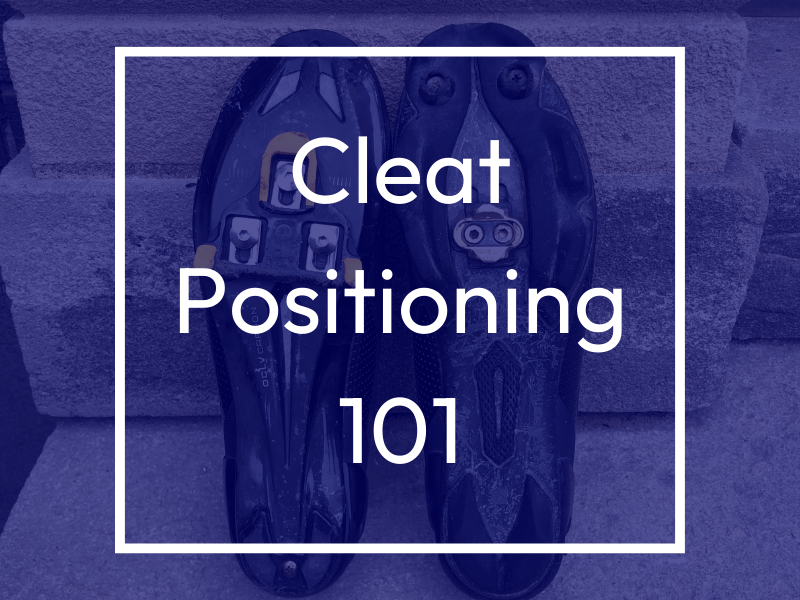
Cycling Cleat Positioning 101
By Justin Goulding
Though the position of your cleats on your shoes may seem trivial, it often goes one of two ways: never noticing them again or pain. To try and make sure you fall firmly outside the pain crowd, we’re going to give you a comprehensive guide you can follow to optimize your cycling cleat positioning. In this article, we’ll cover the basics on the key three elements of how to position your cleats:
- Fore-aft position
- Lateral position
- Rotation
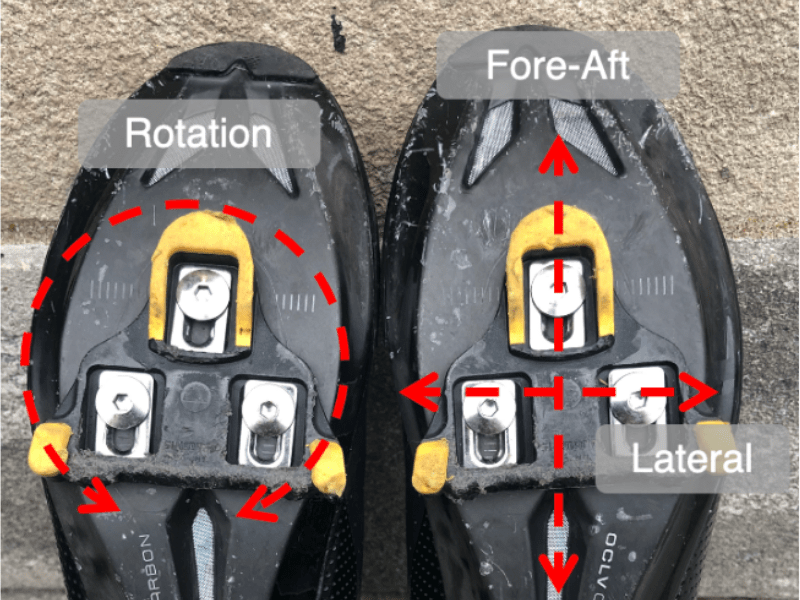
Three key positioning adjustments for cycling cleats: Fore-aft, Lateral, Rotation
DISCLAIMER: Cleat positioning can be quite involved depending on the individual. Riders with significant leg length discrepancies, pronation/supination of the feet, or other lower limb alignment challenges will often benefit from the careful assessment of a professional bike fitter. You may be aware of shimming and wedging of cleats to deal with these issues, and while they can be powerful tools in bike fit, we generally find they are most successfully applied by experienced practitioners.
Clipless Pedals & Cleats
Before we get started it’s good to make sure we’ve covered the basics. There are two general categories of cleats (and associated pedals):
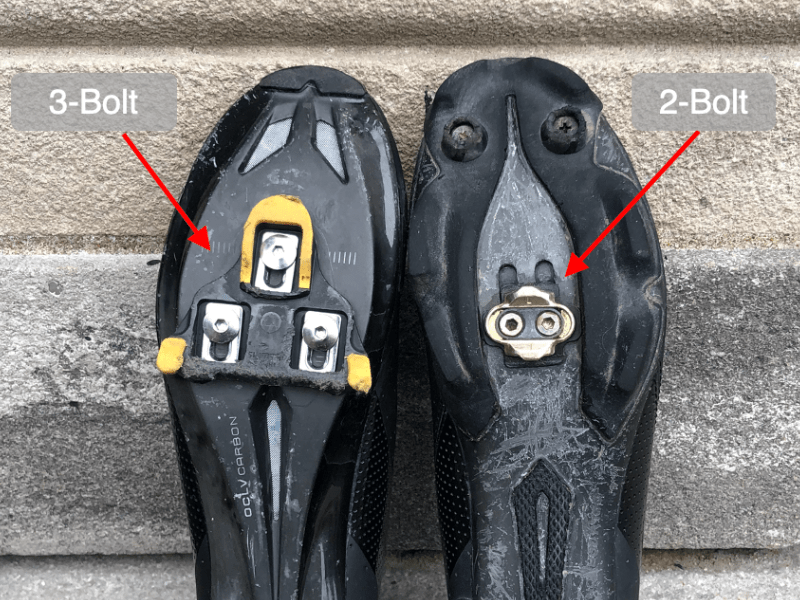
Example of 3-Bolt SPD-SL cleat (left) and 2-bolt Crank Brothers cleat (right)
2-bolt cleat/pedal systems (e.g. SPD , Crank Brothers , Time ATAC , etc.) are typically used in mountain biking and cyclocross, but are also very common amongst touring, recreational riders, spin bikes and gravel riding. Two bolt cleat/pedal systems offer the main advantage that the cleat can be recessed into the tread of the shoe and therefore offer a much better walking experience.
3-bolt pedal systems (e.g. SPD-SL , Look Keo , Time ICLIC , etc.) are almost exclusively used on road bikes and some spin bikes. They offer a larger interface between the cleat and pedal to transfer power, however offer a poor walking experience which is one key reason they are best suited to disciplines that don’t require frequent dismounting.
For the purposes of positioning cleats, the same principles and procedures we discuss apply to both types of cleats/pedals. The main difference to consider is that the fore-aft adjustment for a 2-bolt cleat is accomplished through the sliding of a medal plate within the shoe, whereas on a 3-bolt cleat this adjustment is contained within the adjustability of the cleat itself.
Fore-Aft Cleat Positioning
How far forward or back you position your cleats is likely to make the most noticeable difference in how your bike feels to pedal. Most notably, cleats positioned too far forward can result in dropping the heel and overall instability through the pedal stroke. Proper fore-aft positioning of the cleat will give your foot (and leg) a strong foundation to deliver power through the pedal stroke and minimize the risk of injury.
The method below provides a great way to get your cleats into a solid starting position.
- Locate the head of 1st & 5th metatarsals on each foot.
- Place a piece of masking tape on the sides of yours shoes and use a pen or marker to mark the location of these two metatarsals (they should be the bony bulge you can feel)
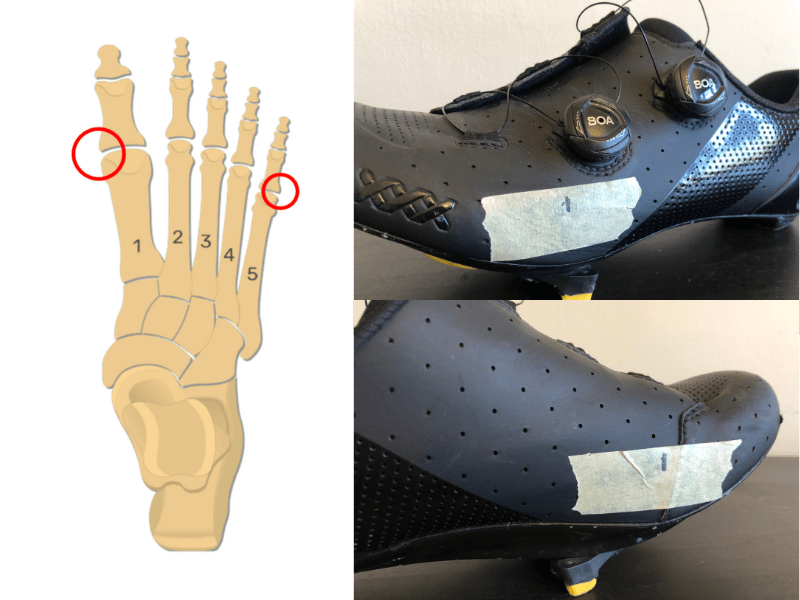
Locating 1st & 5th Metatarsals on your cycling shoes
- Place a piece of masking tape on the sides of yours shoes and use a pen or marker to mark the location of these two metatarsals (they should be the bony bulge you can feel)
- Create a line between these two points
- This line should be across the bottom of the shoe. Depending on your shoes and preference you can do this with another piece of tape, or just using a straight edge object.
- Create a line down the middle of your shoe.
- Draw, or imagine a line down the centre of your shoe (lengthwise).
- Line up the axle marker on your cleat with the intersection of these two lines
- The point at which the two above lines intersect is your starting point for where the axle of your pedal should be located under your foot. Position the axle marker on your cleats (these can be tough to see) such that it lines up with this point.
- Lightly tighten the bolts on your cleats (not all the way)
- Re-Check your position from the 1st metatarsal
- The distance from the point of your 1st metatarsal to the axle marker on your cleats should be >10mm. The larger the shoe size the greater this distance is likely to be. If your axle is less than 10mm back from your first metatarsal, consider repeating the process, or moving your cleat back.
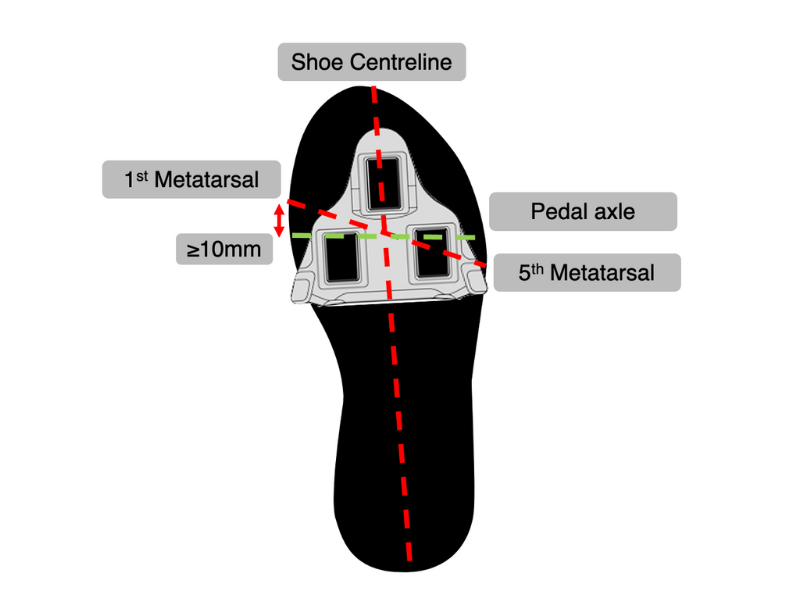
Fore-aft cleat placement overview
NOTE: Moving your cleats rearward on your shoes effectively shortens your leg length and will often result in the need to lower your saddle height. It is advisable to revisit your saddle height with MyVeloFit after changing the fore-aft position of your cleats.
Lateral Cleat Positioning
The lateral position (side-to-side) of your cleats helps determine your overall stance width on the bike (how far apart your feet are). Stance width is a major contributor to how well your knees track through the pedal stroke, as is largely related to your pelvis width.
When discussing stance width, it is important to consider that cleat placement is just one small adjustment in this chain. Your stance width is first affected by the Q Factor of the bike, then your pedal axle width, then finally the lateral position of your cleats. While there is often very little that can be done about the Q Factor of your bike, pedal axle width is something that can be changed for those riders that want to make larger adjustments to their stance width. Shimano and Wahoo/speedplay are perhaps the two most prominent brands that offer extended axle lengths on some models of pedals. These can be particularly helpful for riders that need a wider stance on the bike.
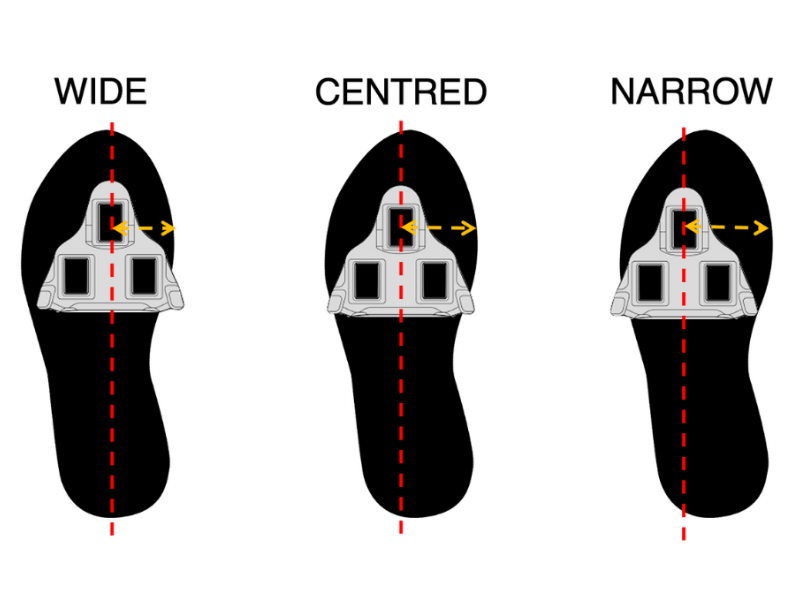
Tips for lateral cleat placement:
- Start in the centre
- Many riders will be well served by a centrally placed cleat. Use this as your starting point.
- Match your stance to your body
- In general larger riders have wider hips, and therefore do well with a wider stance. Consider moving your cleats towards the inside of your shoes to increase your stance width
In general smaller riders have narrower hips, and therefore do well with a narrower stance. Consider moving your cleats towards the outside of your shoes to decrease your stance width
- In general larger riders have wider hips, and therefore do well with a wider stance. Consider moving your cleats towards the inside of your shoes to increase your stance width
- If it ain’t broke, don’t fix it
- If you don’t see (or feel) a reason to stray from a central position, then there is a good chance you may be best-off leaving it there.
Cleat Rotation
Clipping into pedals on your bike has many benefits, though perhaps the most evident drawback is fixing yourself to a very rigid symmetrical machine, when human bodies are anything but. The rotation and float of your cleats will help make sure the interface between your feet and your pedals match up as closely as possible with the way your body moves.
- Sit on the edge of a tall bench or table with your lower legs hanging off the side
Let your feet hang naturally - Observe whether your feet tend to point inwards, straight forward, or outwards
- Reflect the natural angle of your feet in your cleat rotation
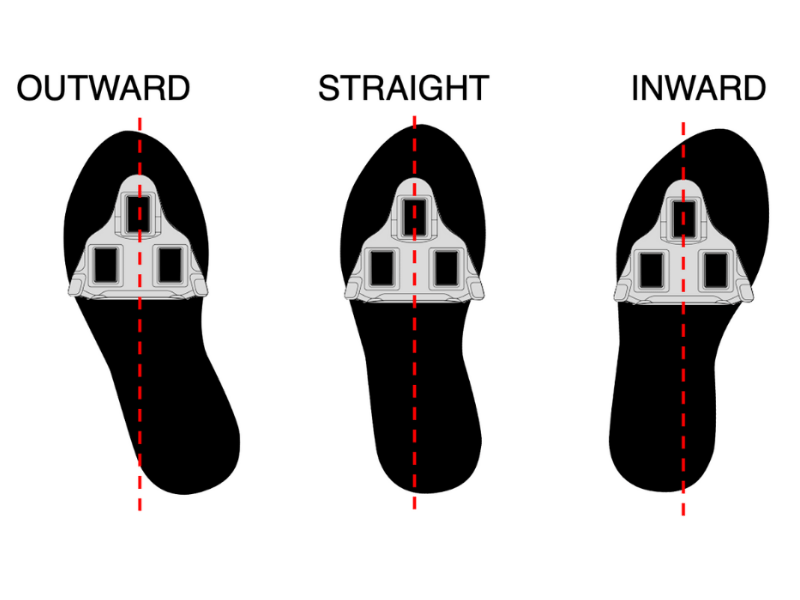
Cleat positioning for feet that point outward, straight ahead, and inward.
Final Steps
The final step is really just to try it out and make sure it all works. Once you’ve got your cleats appropriately tightened/torqued on your shoes (refer to manufacturer specifications), go out for a short spin or ride on the trainer to see how it feels. Do you feel tightness in your hips, knees, or ankles? Do your feet feel like they settle in the middle of the float? Can you feel your heels pushing against the end of your float range? These are all signs that you may need to adjust the rotation of your cleats. If you make changes, be sure to do them in small increments, a little goes a long way.
This is also a great time to check your overall fit on the bike with our fit analysis. Much of your position is related to how your feet interact with the pedals, so taking some time to make sure your position is still working well is always important.
Additional Resources
There is a lot of great information available on how to set up your cleats. We encourage you to check out these other resources if you’re interested to learn more about cleat positioning:
- How to Set Up your Cleats (Francis Cade)
- Want More Power? Two Cleat Positions to Respect! (Cam Nicholls)
- A Do-it Yourself Guide to Fitting Cycling Cleats (CyclingTips)
Justin is a lifelong cyclist that has spent the past 20 years in the bike industry across a variety of roles. His diverse work in sales, procurement, and instructing is all driven by a desire to help more people experience the wonders of cycling. He brings this breadth of experience to building MyVeloFit into a company and service that not only provides bike fits, but one that enables more people to get the most out of cycling.
-
Justin Gouldinghttps://www.myvelofit.com/fit-academy/author/justin/
-
Justin Gouldinghttps://www.myvelofit.com/fit-academy/author/justin/
-
Justin Gouldinghttps://www.myvelofit.com/fit-academy/author/justin/
-
Justin Gouldinghttps://www.myvelofit.com/fit-academy/author/justin/
Justin is a lifelong cyclist that has spent the past 20 years in the bike industry across a variety of roles. His diverse work in sales, procurement, and instructing is all driven by a desire to help more people experience the wonders of cycling. He brings this breadth of experience to building MyVeloFit into a company and service that not only provides bike fits, but one that enables more people to get the most out of cycling.
-
Justin Gouldinghttps://www.myvelofit.com/fit-academy/author/justin/
-
Justin Gouldinghttps://www.myvelofit.com/fit-academy/author/justin/
-
Justin Gouldinghttps://www.myvelofit.com/fit-academy/author/justin/
-
Justin Gouldinghttps://www.myvelofit.com/fit-academy/author/justin/
Ready to get started?
Athletes from around the world use MyVeloFit to improve their cycling position.
Whether you are a veteran or new to the sport, MyVeloFit can help you improve your position.



